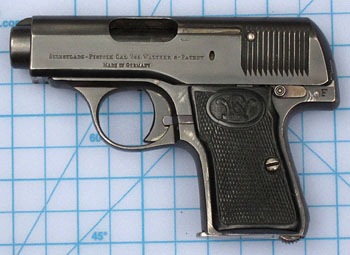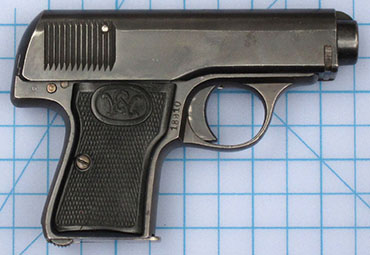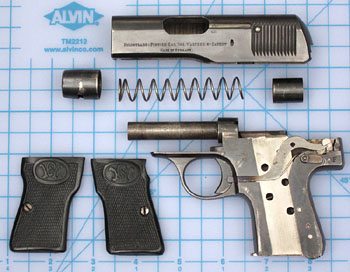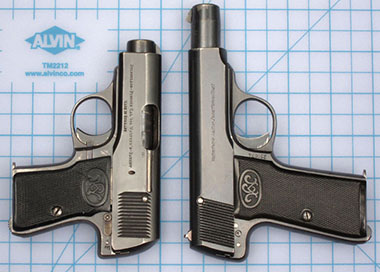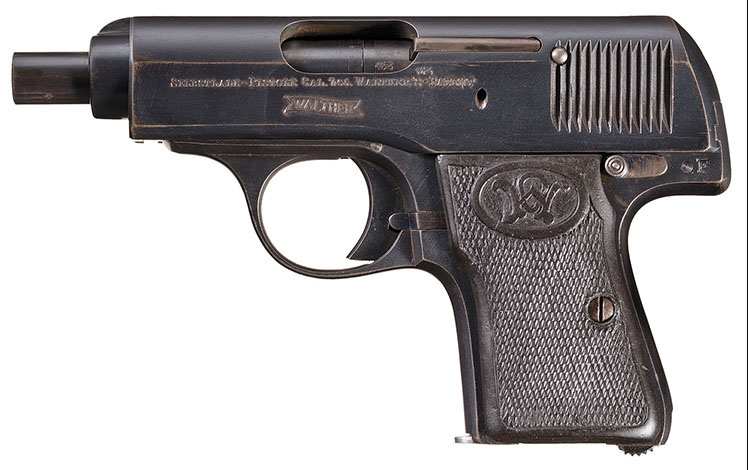 |
||||||||||||||||||||||||||||||||||||||||||||||||||||||||||||||||||||||||||||||||||||||||||||||||||||||||||||||||||||||||||||||||||||||||||||||||||||||||||||||||||
|
The Walther Model 3 by Ed Buffaloe Less seems to be known about the Walther Model 3 than other early Walther pistols, perhaps because there is not a lot to know. None of the English language authors that are often relied on for information about pistols and revolvers (Matthews, Hogg, Ezell, Boothroyd) seem to have ever examined a Model 3 in person, as they all describe the front barrel bushing incorrectly.
The Walther Model 3 is sometimes said to have appeared in 1910, even though the patent that covers the gun was not filed until 22 October 1911. Late 1911 or sometime in 1912 might seem a more likely date for its introduction. The patent was not actually granted until 17 February 1913, but production likely began soon after the patent was filed in 1910. The Model 3 does not appear in the 1911 ALFA catalog, where we find only the Model 1. The Model 3 is listed in the 1913 GECADO (Georg Carl Dornheim) pricelist where, interestingly, it is shown only with the Model 1, not with the Model 2. This is an indication that what we know today as the Model 3 likely preceded the Model 2. Model numbers had not yet been assigned—in 1913 the two pistols were advertised as the “Walther Selbstlade Pistole Kal. 6.35mm” and the” Walther Selbstlade Pistole Kal. 7.65mm”.
The Model 3 is a relatively simple fixed barrel, hammer fired, unlocked breech automatic pistol with the ejection port on the left instead of the right. The external connector runs under the left grip, and is tensioned upward by the long arm of a coil spring mounted on the hammer pin. The connector has a lobe on top that serves as a disconnector when the slide is out of battery. There is an external extractor on the left side of the slide, and a fixed ejector on the right side of the frame. The safety lever behind the hammer blocks the hammer only when it is cocked thus also serving as a cocking indicator. The gun is safe to carry with a round in the chamber. The recoil spring is concentric, with a bushing at each end. The rear bushing covers the rear of the spring in the area of the ejection port, preventing any buildup of dirt in the spring. Instead of a gnurled muzzle nut with a bayonette lug like the Model 2, the Model 3 has a short bushing that forms the front barrel shroud, with a slot on the underside. A spring-loaded horizontal latch fits into the slot to hold the bushing in place. There is a groove on top of the gun for sighting, and a small front sight attached to the front bushing. A few rare examples were made with a barrel that extends out the front of the gun an extra 3/4 of an inch or so. One of these is illustrated in Manfred Kersten’s book Walther: A German Legend. This would appear to be a Model 4 barrel, making it likely that the Model 4 was already in production at an early date, perhaps as early as 1913.
The magazine release pushes to the rear. Most magazines are blued. The magazine in the example I examined is in the white and unmarked; it has a flat follower and has 5 holes drilled in either side for viewing cartridges. The finish on the Model 3 is rust blue. The best-preserved early Model 3 I have seen has a fire-blue finish on the pins, connector bar, extractor, safety lever, and grip screws, though it is possible this gun was refinished since I have not seen others like it. Some authors note that the finish and general quality of manufacture of the Model 3 is markedly better than that of the Model 1. Most Model 3 pistols have 13 vertical triangular-cut slide serrations at the rear, but toward the end of production the rear-most serration was eliminated, leaving 12. These are sometimes referred to as the first and second variant, though the number of serrations is their only difference. The grip plates are made of checkered hard rubber with the CW (Carl Walther) monogram in an oval at the top. The earliest Model 3 pistols I have documented bear the following slide inscription on the left side in all capital serif letters: SELBSTLADE-PISTOLE.CAL.7,65 WALTHER’S-PATENT Later, this same inscription was moved higher on the slide and the Walther banner was stamped beneath it. The early Walther banner has less of a curve to it, known as the “flat” banner, and we find this early banner on the Model 3 as well as on the Model 1. Late Model 3 pistols have the S-curve banner that is still in use. The left side of the slide is normally blank.
At least one example of a Model 3 bears a two-line inscription, as follows: WALTHER’S SELBSTLADE-PISTOLE.CAL.7,65 This is similar to the inscription for a Model 1, and this example appears to have had “6,35” overstamped with “7,65” so it is likely that someone simply used the wrong roll-stamp. Some guns, intended for export, are stamped “MADE IN GERMANY” on the left side of the slide beneath the slide inscription. Some Model 3 pistols are marked in both upper and lower case serif characters on the left side of the slide: Messerfabrik VULKAN G.m.b.H. SOLINGEN, Germany
Some VULKAN-marked guns have the standard “CW” monogram grip plates, but some have checkered hard rubber grip plates that are marked only “Caliber 7,65” in an oval at the top. The exact origin of these pistols is disputed. James L. Rankin believes that Walther sold leftover parts to the Vulkan company when they were about to launch the Model 4, but this theory is undermined by serial number data which indicates that quite a few of Walther-labeled guns were made after the Vulkans. Manfred Kersten believes it more probable that the Vulkans were made for the export market, and this seems likely since there are also Model 1 Walther pistols that are not marked with the Walther name and were likely intended to be marketed by other companies. According to Dieter H. Marschall, in his book Walther Pistols, serial numbers range between 11000 and 35000, though I have not documented serial numbers much above 28000. Most authorities, including Marschall, seem to agree that only approximately 3,500 Model 3 Walthers were ever made. The author would be grateful to anyone willing to share serial number information about their Walther Model 3 pistol.* The Walther Model 3 was quite small for a 7.65mm Browning (.32 ACP) pistol. There was one other 32 of the era that is slightly smaller than the Walther--the Pieper Bayard, which appeared in 1908--the Pieper does not fit the hand as well as the Walther, and carries one less round in the magazine. A number of small Spanish 32’s were made in later years, mostly after the war, though few if any were as well made as the Walther. The modern pistol that is closest in size to the Model 3 is the Kel-Tec P-32, though the Kel-Tec is much thinner and less than half the weight of the Walther.
Disassembly
Do not pull the trigger with the gun disassembled, as it could damage the lockwork. * Write to Ed Buffaloe at edbuffaloe@unblinkingeye.com. Please share photographs and information about the Walther Model 3 . Dating the Early Walther Pistols, Models 1-7
|
||||||||||||||||||||||||||||||||||||||||||||||||||||||||||||||||||||||||||||||||||||||||||||||||||||||||||||||||||||||||||||||||||||||||||||||||||||||||||||||||||
|
Copyright 2013-2023 by Ed Buffaloe. All rights reserved. |
||||||||||||||||||||||||||||||||||||||||||||||||||||||||||||||||||||||||||||||||||||||||||||||||||||||||||||||||||||||||||||||||||||||||||||||||||||||||||||||||||
|
|
||||||||||||||||||||||||||||||||||||||||||||||||||||||||||||||||||||||||||||||||||||||||||||||||||||||||||||||||||||||||||||||||||||||||||||||||||||||||||||||||||
